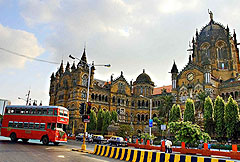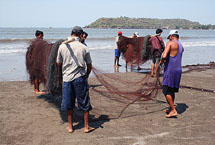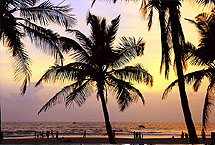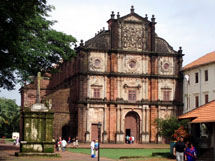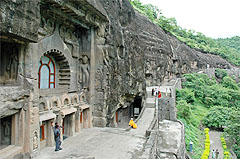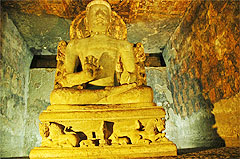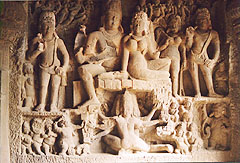|
DAY 01:
Mumbai
On arrival you will be met by our representative & transferred to
hotel, where we will be holding the rooms on ready occupancy basis.
After traditional welcome check in into hotel.
Overnight stay at hotel.
Day 02: Mumbai
The islands forming today's Mumbai were given to Charles II of England
in dowry in 1661. In 1845 the seven islands were merged through the
construction of Mahim causeway. In 1853, India's first railway line
joining Thana and Bombay was inaugurated.
In 1911, the 'Gateway of India', a 26 m high structure, was built in
honour of King George V and Queen Mary. In close proximity is the Taj
Mahal Hotel, built by JN Tata in 1903. The Prince of Wales Museum is a
superb structure, built in Moorish and Gothic styles. The Museum has a
fine collection of Indus Valley artefacts, priceless Tibetan and
Nepali Art, Buddhist tankha scrolls. Tibetan bronzes and over 2000
miniature paintings. Close by is the Bombay Natural History Society,
having a wide collection of flora and fauna.
Overnight stay at hotel.
Day 03: Mumbai - Goa
After breakfast, a small ferry will take you on the famous Elephanta
Island. This island is famous for their stone sculptures. These
temples were built during 9th to 13th century. The Chalukyas of Badami
and the Rashtrakuta of Manyakheta were patrons of these caves. The
Trimurti or trinity of Brahma, Vishnu and Mahesh is superb structure.
The temple complex is considered as the second home of Shiva next to
Kailasa.
We will fly you to Goa in the afternoon. Goa is the living legend of
Portuguese legacy. You will received at the Airport and arrange your
stay in a hotel of your choice. You will love to visit beaches and
pubs of Goa in the evening.
Day 04-06: Goa
After breakfas Goa Beach Sightseeing, City Tour.
Goa is known as "Pearl of the Orient" and often called a "Tourist
Paradise". The glorious scenic beauty and the architectural splendours
of its churches and the Portuguese old houses have made Goa a tourist
hotspot. Goa is much more than sea, beaches and fascinating nightlife.
Its spirit lies in its rich culture, natural scenic beauty and unique
history. As par the Hindu mythology, Parshuram an incarnation of
Vishnu had created Goa.
Goa is also famous for churches like Basilica of Bom Jesus, a World
Heritage site and Cathedral and Church of the Three Magi Kings. Goa is
also famous for the Shanta Durga Temple, the Shri Manghesi Temple, the
Mahalaxmi Temple and the Shri Ganpati Temple. Goa is known for rice,
fish-curry and fenny, a local variety of wine. In Goan cuisine spices
and seafood like prawns, ladyfish, mussels and lobsters are necessary
ingredients.
Overnight stay at hotel.
Day 07: Goa - Aurangabad
After
leisurely breakfast drive you to Aurangabad and arrange your stay in a
heritage hotel.
Ajanta and Ellora surround AURANGABAD, named after the Mughal Emperor
Aurangzeb. The city was earlier known as Burhanpur. In 1681 the city
became residence of the Mughal Emperor Aurangzeb. Aurangabad was the
base for his campaigns to conquer the last remaining Deccani
Sultanates until his death in 1707 AD.
Overnight stay at hotel.
Day 08-10; Ajanta Caves
After breakfast Ajanta Sightseeing
These monuments dating back from 2nd century BC containing paintings
and sculptures are considered masterpieces of the Buddhist Religious
arts. The monastic composites of Ajanta consist of Vihara (monastery),
Chaitya (worshiping hall) and Stupa (monuments built upon relics of
Buddha). The Ajanta caves can be distinguished into two architectural
phases, separated from each other by almost four hundred years. The
first phase coincides with the older Hinayana school of Buddhist
thought where the Buddha was represented in symbols like a throne, a
set of footprints or the Stupa. Later, Mahayana sect gave Buddha a
human form.
The ancient artists of Ajanta covered the wall with a layer of mud and
cow dung mixed with straw as a binding medium. This layer was
smoothened by plaster of lime or gypsum. It was upon this that the
painters created their worlds of colour. The paintings of Ajanta are
different from frescoes. In fresco, paintings were done on moist wall
while in Ajanta, the painting were done on dry walls. Another amazing
fact about the painting is that they were done in extremely poor light
conditions in the caves.
Cave 1: This was the earliest discovered cave and has no relation
to the chronological sequence of the caves. This cave has one of the
most elaborate carvings on the facade with relief sculptures on
entablature and fridges. There are scenes carved from the life of the
Buddha as well as a number of decorative motifs. The sidewalls
antechambers are painted with murals showing two important episodes
from the Buddha's life. The left wall narrates the story of Gautama
being tempted by Mara just before he became the Buddha. The right wall
depicts the miracle of Sravasti.
Cave 2: This cave is the adjoining cave. It is in a better state
of preservation though looks similar as Cave. It is known specifically
for the paintings that have been preserved on its walls, ceilings, and
pillars.
Cave 9: This cave is one of the oldest and dated back to 1st
century BC. This Chaitya has a vaulted ceiling that was originally
supported by wooden beams. Some of the paintings have similarities
with those of Sanchi, the largest Stupa in India.
Cave 16: It is one of the most beautiful caves of Ajanta dating
back to 475 to 500AD. Its antecedents are recorded on an inscription
on the left outer wall. The cave was made for the use ascetic.
Varahadeva, a minister of the Vakataka king, Harisena, funded the
cave.
Cave 17: Apart from an elaborately- carved doorway, this cave is
especially remarkable for the number of survived murals. The
masterpiece is a panel just behind gateway depicting seven Buddhas
including Maitreya or the Future Buddha. Directly below the row of
Buddhas, is a line of eight couples in different poses of lovemaking.
Perhaps the most beautiful of all the paintings of Ajanta is the
figure of the dark-skinned apsaras with a turban like headgear.
Cave 26: This cave is larger than cave 17 but is similar in
decoration and arrangement. The main attraction is the figure of the
Buddha seated in the pralambha-pada position under a pavilion. And
Evening Back hotel
Overnight stay at hotel.
Day 11 : Ellora
After Breakfast Full Day Ellora Sightseeing.
Ellora consists of 34 monasteries and temples, extending over more
than 2 km. These monuments date back to 600 to 1000 AD. The 12
Buddhist (caves 1-12), 17 Hindu (caves 13-29) and 5 Jain caves (caves
30-34), built in close proximity, demonstrate the religious tolerance
prevalent during this period of Indian history.
The Buddhist caves were the earliest structures, created between the
fifth and seventh centuries. These consist mostly of Viharas or
monasteries. A few of these caves have shrines and statuettes of
Buddha, Bodhisattvas and saints. In many of these caves, sculptors had
endeavoured to give the stone the look of wood.
Buddhist Cave 12 or Tin Tala has a relatively plain structure with
austere pillars and the sculptured panels are only on the inner walls.
Its historical value lies in the fact that human hands shaped a three-
storied structure from solid rock with such meticulous skill that even
the floors and the ceiling are even and levelled.
Cave 10, the 'Vishwakarma cave', also called the 'Carpenter's Cave'
has a Stupa hall akin to a cathedral beyond its multi-storeyed
entrance. Its ceiling is so carved that it gives the impression of
wooden beams. At the centre of the cave is a 15-foot sculpture of
Buddha seated in a preaching position.
KailasnathTemple's excavation must rank as an architectural wonder.
Two great trenches some 90 meters long were dug into the hillside.
These were connected at the innermost point by another trench 53
meters across. The temple appears as rising from a vast courtyard at
ground level. The temple is dedicated to Shiva.
Further 2 Kms along the rock-face are the Jain caves, the most recent
of the lot, having been excavated between 800-1100AD. Of this Cave 30,
the Chhota Kailasa and Cave 32, the Indrasabha cave is the most
striking. Chhota Kailasa is a miniaturized version of the stupendous
Hindu Kailasa Temple. However, the masterpiece of the Jain caves is
the two-storied Indrasabha temple having a huge dhwajastambha (flag
cliff) and an elephant statue.
and evening back to Hotel , Overnight stay at hotel.
Day 12; Ellora to Mumabai
After breakfast we drive back to Mumbai |
|


 Have a query about your booking?
Have a query about your booking?

